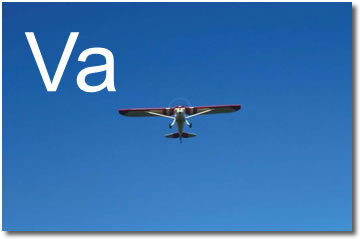 |
|
Maneuvering Speed
“Any
fool can carry on but a wise man knows how to shorten sail in time.” Turbulence is something we all experience at one time or another. In ground school we learned the theoretical explanation: turbulence is an irregular movement of air resulting from eddies and vertical currents; it is produced under four types of conditions. Mechanical turbulence is produced when air passes over the ground, particularly irregular ground, and man made objects. Thermal turbulence is a result of differential ground heating. Frontal turbulence is produced along the interface of moving air masses, and wind shear, a shift in wind direction or velocity at altitude, can produce significant turbulence. Regardless the source of turbulence, the experience of pilots, passengers and the aircraft itself is the same. Depending of the severity of the turbulence, we can expect all the delights of discomfort, airsickness, possible injury, and, in severe cases, potential loss of control or structural damage to the aircraft. It is important to understand the causes of turbulence, to learn to recognise situations that may be difficult or hazardous and to understand the limitations and procedures to ensure safe flight in your aircraft. Two important items on our list of things to know and understand are the load limits of the particular aircraft we are flying and our aircraft’s maneuvring speed, Va. As a friend of mine said, “Isn’t Va number in the POH? Or is there more to it?” The answer is to that is, of course, yes. The POH for the aircraft you fly will provide specific information regarding load limits. The vast majority of aircraft flying with a Certificate of Airworthiness (C of A) are classified in either the Normal or Utility category. In order to hold a C of A in the Normal category, an aircraft must be able to safely withstand a load of +3.8g and –1.52g. Utility category aircraft must safely withstand a load of +4.4g and –1.76g. These are the legally established minimums (see PART V - AIRWORTHINESS MANUAL CHAPTER 523-VLA). Some aircraft may be flown in either category, the C-172, for example, depending on how it is loaded with passengers, baggage and fuel. Most aircraft are designed to exceed these minimums. If we look in the POH for our 1976 Cessna 172M, for example, we see that the aircraft meets or exceeds the minimum requirements and is designed to have a 50% “safety factor” above and beyond the minimums. This “safety factor” would define the “ultimate load factor”. When this limit is exceeded, parts of the aircraft’s primary structure, i.e. wings, empenage, engine, may begin to depart company (1). It is important to note, in the case of Cessna, the design load factor limit drops to +3.0 with flaps extended. The POH does not give information regarding load limits for negative g’s with flaps deployed, but we do note that the negative g load limit is considerably less than that given and required for positive loading. This means, in the case of our 172, we can impose a load with flaps up of +3.8g’s, or –1.52g’s with the aircraft loaded in accordance with Normal Category specifications without damaging the aircraft. Applying a slightly greater load to the aircraft will not immediately result in the loss of vital surfaces or components due to the built-in safety factor. However, we all know the story about old pilots and bold pilots. Knowingly stressing an aircraft above its limits can lead to serious and possibly fatal consequences down the line, if not sooner. A g is a measure of acceleration. When we are speaking about aircraft we normally measure g’s in terms of the weight-to-lift ratio. In normal, unaccelerated flight, we experience a 1g load: the lift produced by the airfoils is equal to the weight of the aircraft, including any tail loading being produced. We can say, under these conditions, that the load factor, the ratio between the dead load, the weight of the aircraft, and the live load, the increased weight of the aircraft caused by acceleration is 1 (2). If we change our aircraft’s attitude -- apply control inputs -- bank the aircraft or initiate a climb or any other maneuver, we produce acceleration as a natural outcome of changing the aircraft’s flight path. The more rapidly or aggressively we change the aircraft’s flight path the greater the acceleration. Acceleration increases the live load. Increasing the live load increases the load factor. The greater the acceleration we produce -- the greater the difference between weight and lift -- the greater the load on the aircraft. We can think of acceleration loading as the difference between the amount of lift required to hold the aircraft in level, unaccelerated flight, and the additional lift we have created by control inputs that causes change in the aircraft’s flight path. The formula for lift, which we all remember from ground school, is: Lift = CLS(r/2)V2. The formula tells us that lift is equal to one-half the product of four factors: · The Angle of Attack. Increasing the angle of attack increases the amount of lift and reaches its maximum value at the Critical Angle of Attack. Increasing the angle of attack beyond the critical angle of attack results in a significant reduction of lift: a stall. The point at which the stall is reached depends on the shape of the wing profile. This is expressed in the formula for lift by the Coefficient of Lift (CL); the critical angle of attack, the angle at which maximum lift is produced, is represented as CLmax.
For our purposes, we can assume that the CL, S and r remain constant. Once our aircraft is loaded and in the air we have little ability to change the coefficient of lift (except as a function of angle of attack), the surface area of our wings or the air density. To simplify our lives we can assign their product in the formula for lift a constant value, let’s say “K”. So we can look at our formula, in its simplified form, as Lift = KV2. Lift is equal to K times the square of the velocity. This lets us see a bit more clearly the relationship between lift and air speed. Lift increases with the square of the air speed. Let’s go back aboard the 172 and see how this works. If we slow the 172 down to just at stall speed, flying at our maximum angle of attack (CLmax), and pull the control column full back, the aircraft will stall; we and the aircraft will experience a 1g load. The wings are incapable of producing more than 1 g at that speed. If we pull our control column full back while flying at a higher speed and smaller angle of attack, we will produce more than a 1g load; at the moment of stall, we will be accelerating. For the sake of simplicity, let’s say the aircraft will perform a 1g stall at 50 knots (flaps up). As we just discussed, the load applied to our aircraft is increased by the square of the speed. If we increase our speed to say 1.41 times the stall speed, 70.5 knots, and apply full elevator input to stall the aircraft, we find we experience a 2g load (1.41 x 1.41 = 2). If we were to double the speed at which we stall the aircraft, say from 50 knots to 100 knots, we increase the load by four times (4 being the square of 2). If we apply full control inputs at 100 knots and stall the aircraft, instead of the mild, rather pleasant 1g stall, we and the aircraft will experience a 4g dose of acceleration. This could well pose a problem if our aircraft is operating in the normal category and is rated to accept a +3.8g load. How do we determine the maximum speed at which we can safely apply full control inputs without exceeding our load limits? We work backwards from the correct answer. Without beating the math to death, we remember that a 45° bank turn produces a 1.41g loading; a 60° bank turn produces a 2g loading. We can look these values up and save ourselves some effort, or we can work them out ourselves. We can derive them either mathematically or geometrically. Mathematically, we find that G = 1/cos ?. One divided by the cosine of our angle of bank is the multiplier of our weight to find live load or “G” force. For example, cos 60° = 0.5; 1/cos 60° = 2.0. Geometrically we can draw the triangles representing vertical and horizontal lift, measure the lengths of the sides and work out the ratio between weight and lift. While we are speaking here about turns, any change in an aircraft’s flight path--up, down or sideways--will produce the same acceleration results. If we go back to our formula for Lift, using our simplified version (Lift = KV2), remembering that at the moment of stall Weight is equal to Lift, we can say that Weight = KV2). From this, we can find the relationship between Lift and Velocity by solving for V: V = vW/ K: stall speed increases with the square root of the load factor. For example, if our aircraft normally stalls at 50 knots in level, unaccelerated flight, in a 45° bank turn we can expect a stall speed of 59.4 Knots (50 x v1.41). In a 60° bank turn we can expect a stall speed of 70.7 (50 x v2). To calculate the maximum stall speed that will keep
us on the sunny side of our load factor, we should ask ourselves this
question: at what stall speed will the lift produce a load factor of 3.8?
Since stall speed increases with the square root of the load factor we
can say the square root of our maximum load factor (3.8) multiplied by
the stall speed (Vs): (50 x 1.95 = 97.5) will be our maximum speed. At
any airspeed less than Vs times the square root of our maximum load factor,
our aircraft will stall before more load is imposed on it than it is designed
to handle. The wings cannot produce more load than the aircraft is designed
to deal with. Enter the concept of Manoeuvring Speed (Va). As we grow and develop as pilots, we begin to take on new challenges. Developing a deeper understanding of Va becomes essential, particularly if we start thinking about doing any mountain flying or extending our range to distant points from which we will not be able to immediately “return to base” if the weather begins to deteriorate. The bottom line: Va is the speed below which our aircraft will stall rather than bend or break when we impose or have imposed on us—as in the event of a vertical gust—an increased load. But, as with most things, the devil is in the details. If we go back to the POH for our 172, we read that the Manoeuvring speed is given for three weights: Weight Va 2300 lbs 96 KCAS If we check our POH we see that the actual stall speed at full weight can vary between 50 KCAS and 53 KCAS depending on how forward or aft the C of G is located. This will give us an actual Va (Vs x vmax load factor) of between 97.5 KCAS and 103.4 KIAS at maximum gross weight. Cessna, appropriately, chooses to err on the conservative side in its published figures. As pilots who intend to become old pilots, we should be encouraged to do the same. Why, we might ask, does Va decrease with weight? This is a key point and a very interesting one. As we discussed earlier, the stress or load factor imposed on the aircraft when it is accelerated is a function of the lift to weight ratio. At full weight, 2300 lbs for our 172 in the Normal category, we can impose 3.8g’s, a 3.8 load factor, and remain within safe parameters. If Lift/Weight = Load Factor, then Lift = Weight x Load Factor. We can generate a total of 8740 lbs of lift by sudden control input (2300 x 3.8 = 8740) and remain within design limits. The designers of the aircraft have structured the machine to be robust enough to withstand the 3.8 load factor at full weight. Let’s lighten the aircraft and see what happens. If we toss out our passengers and burn off some of the fuel, we might achieve a gross weight of 1600 lbs. At full weight, 2300 lbs, we happily stalled our aircraft at 97.5 KCAS and discovered we experienced 3.8g’s (8740/2300 = 3.8). At our new and lighter weight, we can develop the same amount of lift at the same airspeed. Remember the formula: aircraft weight is not a factor in the production of lift. Unfortunately, when we do the math, we discover that 8740/1600 = 5.5. We’ve exceeded our load limit by 1.7g’s. If we could manage to lighten our aircraft to half its full weight, 1150 lbs, we would find the abrupt stall would now produce a very undesirable 7.6g’s (8740/1150 = 7.6). Kids, don’t try this at home! Let’s see if we can follow the logic through. The mathematical symbology is clear and simple to those who enjoy the math, but we’ll work through it both ways. First, in plain English: The formula for lift says that lift is equal to the coefficient of lift, multiplied by the surface area of the aircraft’s wing, multiplied by half the air density, multiplied by the square of the velocity (L = CLS(r/2)V2 ). Using the simplified version we discussed earlier we can say that L = K V2. We know that a wing stalls just past the angle at which it is providing maximum lift, so we can refer to our CL in terms of its maximum value, CLmax(4). If we make a small jump and say that lift, in a 1g, unaccelerated situation is equal to weight, we see that the aircraft weight is also equal to the coefficient of lift, multiplied by the surface are of the wing, multiplied by half the air density, multiplied by the square of the velocity (W = KV2 ) (5). If we take one more step and solve for V (velocity), we see that velocity is equal to the square root of the weight divided by the coefficient of lift, times the surface area, times the air density (V = vW/K ). If we plug in our known numbers, V = 50 Knots, W = 2300 lbs, we can determine a value for K. In this case it is 0.92 (50x50 = 2300/0.92). We know, from the POH, that stall speed at gross weight, depending on the location of the C of G, is approximately 50 Knots. To calculate the stall speed for a lighter weight, we pop the new weight into our handy, little formula. Let’s try one with say a weight of 1600 lbs. We would say that V2 = 1600/0.92. In this case we find that our 1g stall speed at 1600 lbs would be 41.7 Knots. A rule of thumb suggested by William Kershner for finding the effects of weight change on airspeed is to, “…reduce the airspeed by one-half of the percentage of the Weight reduction”(6). In this case that would give us a “rule of thumb” stall speed of approximately 42.5 Knots. It isn’t quite as precise, but it certainly is in the ballpark. I don’t know about your eyes, but I would certainly have a difficult time finding the difference on the airspeed indicator between 41.7 and 42.5. Working back up to calculate our Va, remember we multiply the stall speed by the square root of the load factor. In this case 41.7 x 1.99 = 81.3. Checking our POH chart, we see that Cessna recommends a Va at 1600 lbs of 80 KCAS. So, here we are, ready to go flying. Not too many of us are willing to do all the calculations when we are actually flying, especially if the air is a bit turbulent. Nor do we need to do them if we have some reasonable rules of thumb to follow that will keep our passengers and us safe and sound. Here are the rules handed down to me by my mentor, Captain John Spronk: In Smooth flying conditions:
In Light Turbulence:
In Moderate Turbulence:
In Severe Turbulence:
End Notes: 1. Kershner, William K., The Advanced Pilot’s
Flight Manual, Sixth Edition, Iowa State University Press, Ames, Iowa,
USA, 1994, pg.146.
|



